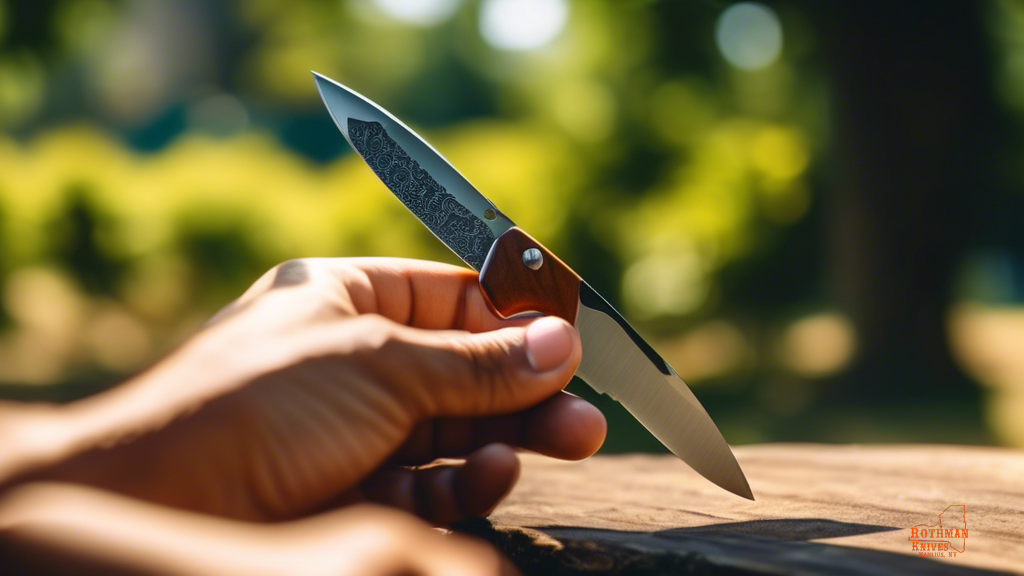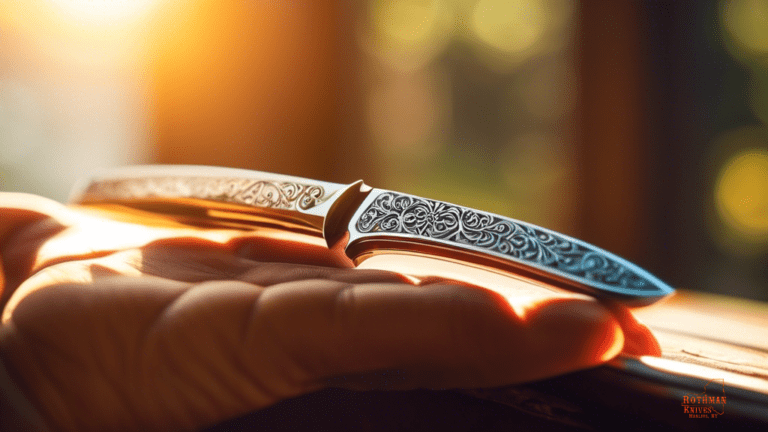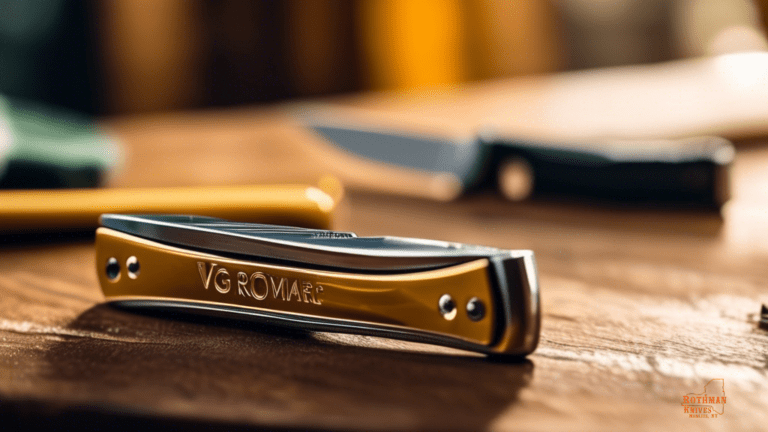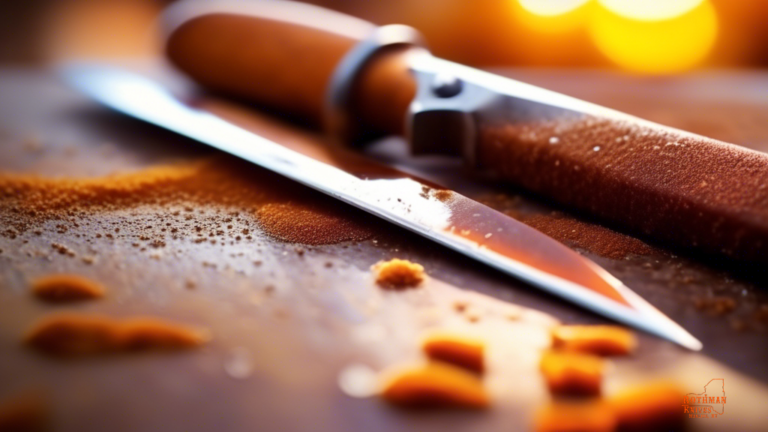Are you looking to keep your folding pocket knives sharp and ready for any task that comes your way? Look no further! In this guide, we will walk you through the process of sharpening your folding pocket knives like a pro.
With the right tools and techniques, you can ensure that your knives are always in top-notch condition, ready to tackle any cutting or slicing challenge that may arise.
You may have a collection of folding pocket knives that hold sentimental value or simply serve as practical tools for your everyday needs. By learning how to properly sharpen and maintain them, you can extend their lifespan and keep them performing at their best.
So grab your sharpening tools and let’s dive into the world of knife sharpening together!
Key Takeaways
- Importance of keeping folding pocket knives sharp
- Using the right tools for sharpening
- Understanding the blade angle for sharpening
- Maintenance tips for longevity of folding pocket knives
Choosing the Right Sharpening Tools
You’ll want to make sure you have the proper tools on hand to keep your folding pocket knife in top shape.
When it comes to sharpening your knife, having the right tools can make all the difference. Look for a sharpening stone or a sharpening rod that fits the size of your blade.
Additionally, consider investing in a honing oil or lubricant to ensure a smooth sharpening process.
Having these tools at your disposal will not only make sharpening easier but also help prolong the life of your knife.
Remember, the key to sharpening your folding pocket knife is consistency and using the right tools.
By investing in quality sharpening tools, you can ensure that your knife stays sharp and ready for any task.
So, gather your tools, find a comfortable workspace, and get ready to give your folding pocket knife the sharpening it deserves.
Understanding the Blade Angle
Understanding the blade angle is crucial for achieving a sharp edge on your knife. The angle at which you sharpen your blade can greatly impact its cutting performance and durability.
Here are four key points to keep in mind when considering the blade angle:
- Low Angles for Razor Sharpness: A lower blade angle, typically around 15-20 degrees, will result in a razor-sharp edge. This angle is ideal for tasks that require precision cutting, such as whittling or slicing.
- High Angles for Durability: On the other hand, a higher blade angle, around 25-30 degrees, will provide more durability for tasks that involve tougher materials. This angle is suitable for outdoor activities like camping or hunting where the knife may encounter rough surfaces.
- Consistency is Key: Maintaining a consistent blade angle during sharpening is essential for achieving a uniform edge. Varying the angle can lead to an uneven edge, affecting the knife’s cutting performance.
- Experiment and Find Your Sweet Spot: Every knife is different, so it’s essential to experiment with different blade angles to find what works best for your specific knife and intended use. Take your time to practice sharpening at different angles to discover your knife’s sweet spot for optimal performance.
Step-by-Step Sharpening Process
Get ready to master the step-by-step process of honing your blade.
First, gather all the necessary tools: a sharpening stone, lubricating oil, and your trusty folding pocket knife. Find a comfortable and well-lit workspace where you can focus on the task at hand.
Next, start by applying a few drops of lubricating oil to the sharpening stone. Hold the knife at a 20-degree angle against the stone, with the blade facing away from you. Using gentle pressure, slide the blade across the stone in a smooth, circular motion. Repeat this process on both sides of the blade until you achieve a sharp edge.
Remember, practice makes perfect, so don’t be discouraged if you don’t get it right the first time. With patience and dedication, you’ll soon be sharpening your folding pocket knife like a pro.
Testing the Sharpness
MAIN TOPIC:
a guide to sharpening folding pocket knives
PREVIOUS SUBTOPIC: "Step-by-Step Sharpening Process"
CURRENT SUBTOPIC: "Testing the Sharpness"
Once your blade is honed to perfection, it’s time to put it to the test and see how sharp it really is! Testing the sharpness of your knife is an important step to ensure that your efforts in sharpening have paid off. Here is a simple test you can perform to check the sharpness of your blade:
| Test | Description |
|---|---|
| Paper Test | Hold a piece of paper vertically with one hand and gently place the blade at the top edge. Push the blade down while maintaining a slight angle. If the knife easily slices through the paper with a clean cut, your knife is sharp. If it tears or struggles to cut, it may need further sharpening. |
| Hair Test | Another common test is to see if your knife can cleanly shave a small patch of hair on your arm or leg. If the blade effortlessly shaves hair without tugging or pulling, it is considered sharp. If it struggles or pulls on the hair, more sharpening is required. |
| Vegetable Test | Lastly, try cutting through a firm vegetable like a tomato or cucumber. A sharp knife should effortlessly slice through the vegetable with minimal effort. If the blade squishes or struggles to cut, it needs more sharpening. |
By performing these simple tests, you can ensure that your folding pocket knife is sharpened to perfection and ready for any cutting task that comes its way.
Maintenance Tips for Longevity
To ensure your knife lasts a lifetime, regular maintenance is key. Just like a car needs oil changes to keep running smoothly, your pocket knife needs a little TLC to stay sharp and in top condition.
One simple maintenance tip is to clean your knife regularly. Use a soft cloth to wipe off any dirt, debris, or residue that may have accumulated on the blade. This not only keeps your knife looking good but also prevents any build-up that could affect its performance.
Another important maintenance tip is to lubricate your knife. A drop of oil on the pivot points and blade can go a long way in keeping your knife opening and closing smoothly. It also helps prevent rust and corrosion, extending the life of your trusty tool.
By taking these simple steps to care for your folding pocket knife, you’re not only ensuring its longevity but also becoming part of a community of knife enthusiasts who understand the importance of proper maintenance. So, grab that cloth, a drop of oil, and show your knife some love!
Frequently Asked Questions
Can I sharpen a serrated blade using the same techniques as a straight edge blade?
Sharpening a serrated blade isn’t the same as a straight edge. It’s like comparing apples and oranges! You need a special serrated knife sharpener. Don’t worry, you’ll still get those blades razor-sharp.
How often should I sharpen my folding pocket knife?
You should sharpen your folding pocket knife as needed, depending on how often you use it. Regular maintenance is key to keeping it sharp and ready for use. Trust your instincts and keep it sharp!
Is it necessary to oil or lubricate the blade after sharpening?
After sharpening your pocket knife, it’s crucial to oil or lubricate the blade. This helps prevent corrosion, reduces friction, and keeps your knife in top condition. Don’t forget this important step for optimal performance.
Can I use a sharpening stone on a knife with a coated blade?
Sure thing, bud! Using a sharpening stone on a coated blade can be tricky. Make sure to go slow and gentle to avoid damaging the coating. It’s like delicately peeling an ancient scroll.
What are some common mistakes to avoid when sharpening a folding pocket knife?
When sharpening a folding pocket knife, avoid common mistakes like using too much pressure, not maintaining the correct angle, and neglecting to regularly clean your sharpening tools. Stay patient and consistent for best results.
Last Updated: July 15, 2024
Verified and Approved by:

Mike Rothman
Founder of Rothman Knives
Like This Article?
Share with your friends
Table of Contents
Latest Articles
Keep Reading
-
Unique And Custom Designs For Folding Pocket Knives
Explore the world of unique and custom folding knife designs, featuring intricate engravings and innovative materials. Find your perfect blade today and stand out from the crowd with a one-of-a-kind pocket knife!
-
Essential Maintenance Tips For Folding Pocket Knives
Learn how to keep your folding pocket knives in top shape with these essential knife maintenance tips. Keep your blades sharp and ready for anything by following our expert advice today!
-
How To Remove Rust From Your Knives
Say goodbye to rusty knives with these expert tips on cleaning rusty knives. Keep your kitchen essentials sharp and clean by learning the best techniques for removing rust today!




